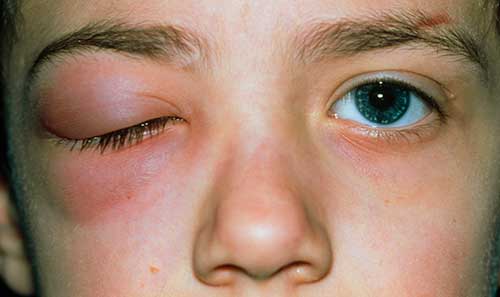About cellulitis
Cellulitis is a skin infection caused by bacteria.
Bacteria live on the skin. They can get into the skin layers through a break in the skin. Many things can cause skin breaks, including splinters, abrasions and cuts, insect bites, surgery, or skin problems like ringworm, scabies or eczema.
Children are more likely to get cellulitis if they have weakened immune systems because of medicine or a medical condition, type-1 diabetes or type-2 diabetes. Children with obesity and teenagers with obesity are also at higher risk of cellulitis.
Symptoms of cellulitis
Cellulitis usually starts as a small, inflamed lump that’s warm and tender to the touch. On children with dark skin, the lump might also look brown, purple or grey. On children with light skin, the lump might look red. You might notice a nearby cut, scratch or insect bite on your child’s skin.
As the infection spreads, the area of inflammation might grow larger and look swollen. Sometimes you might see pus or blisters in the area.
Your child might also develop a fever, lose their appetite, seem tired or feel generally unwell.
Your child might have swollen lymph nodes in the area – for example, under their arm if the infection is somewhere on the skin of their arm.
Cellulitis infection around the eye: symptoms
Cellulitis that affects the skin around the eye is called periorbital cellulitis. It’s a serious condition because the infection can spread to the eye, which is called orbital cellulitis. The infection can also spread to the skull and brain.
Signs of periorbital or orbital cellulitis include:
- a lot of inflammation and swelling around one eye or both eyes
- eye pain or tenderness
- difficulty moving the eyes
- decreased vision in one eye or both eyes
- bulging around one or both eyes
- severe or persistent headache
- feelings of being generally unwell.
Cellulitis infection in the blood: symptoms
A cellulitis infection can spread to the muscle, bone and blood. This can be severe and life-threatening.
Signs of a blood infection include:
- a temperature above 38°C
- pale and clammy skin
- blue or mottled skin, particularly on the hands, feet and cheeks
- tiredness and inability to wake up when gently shaken
- difficulty breathing
- fewer wees or wet nappies.

Medical help: when to get it for children with cellulitis symptoms
You should take your child to see the GP if they have cellulitis symptoms, especially if you see the following:
- The affected skin is on your child’s face.
- Your child has signs of cellulitis and also a weakened immune system or diabetes.
- The inflammation is spreading very quickly or becoming very painful.
- There’s an abscess under your child’s skin that might need draining.
- The cause of cellulitis is a bite, either animal or human.
Seek immediate medical attention for the following reasons:
- You think that your child has a blood infection – take your child to a hospital emergency department or call 000 for an ambulance.
- Your child has signs of cellulitis around the eyes – go to your GP or a hospital emergency department.
Treatment for cellulitis
Treatment for cellulitis depends on how severe the infection is and whether there are signs of a blood infection.
Your doctor might take a swab of the infected area and any pus to work out what bacteria is causing the infection. Blood tests are generally needed only for severe cases.
If there’s fluid or pus in the wound, your doctor might drain it. This often relieves the pain quickly and removes a lot of pus from the area.
Your doctor will usually prescribe oral antibiotics for your child.
If your child has pain or a fever that’s making them uncomfortable, you can give them pain medicine like paracetamol or ibuprofen according to the instructions on the packet.
If your child has cellulitis of the leg or arm, it’s a good idea to rest the limb as much as possible, using a sling or a splint if your child can manage this. Also raise the limb by laying your child down or resting the limb on a cushion. This will help to reduce swelling and pain.
Cellulitis usually gets better quickly if your child takes the full course of antibiotics and rests. Your GP might want to see your child daily to make sure that the treatment is working.
It’s helpful to draw a line around the margins of the cellulitis with a permanent marker pen, so you can see how the area of the infection changes from day to day. Don’t wash off this line – it can help you and the GP work out whether the infection is spreading or getting better.
If your child has severe cellulitis or is extremely unwell, they might need some time in hospital to have antibiotics directly into a vein through a drip. They might also be given fluids and other medicines.
Prevention of cellulitis
The best way to prevent cellulitis is by cleaning all cuts and abrasions as soon as they happen with cool running water.
Wipe with saline or diluted antiseptic solution. Wipe away from the injury to avoid getting new bacteria into the wound. If the cut or abrasion isn’t bleeding, put a thin smear of a plain moisturiser or a petroleum jelly like Vaseline on it. Then cover it with a sterile, non-stick dressing.
Cellulitis isn’t usually contagious. But the bacteria that cause cellulitis can spread to another person if the person has an open wound. This is why it’s important to wash the wound and your hands regularly with soap-free wash and lukewarm water.